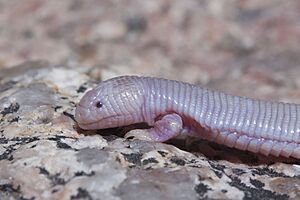Mexican mole lizard facts for kids
The Mexican mole lizard (Bipes biporus) is a unique animal. It is also called the five-toed worm lizard or simply Bipes. This creature is a type of amphisbaenian, which are often called "worm lizards." It belongs to the family Bipedidae. You can only find this species in the Baja California Peninsula in Mexico. What makes it special is that it's one of only three types of worm lizards that have legs!
Quick facts for kids Mexican mole lizard |
|
|---|---|
 |
|
| Conservation status | |
| Scientific classification | |
| Genus: |
Bipes
|
| Species: |
biporus
|
| Synonyms | |
|
|
Contents
About the Mexican Mole Lizard
The Mexican mole lizard looks like a pink worm. It is about 18 to 24 centimeters (7 to 9.5 inches) long from its snout to its tail. It is only about 6 to 7 millimeters (0.2 to 0.3 inches) wide. These lizards usually live for one to two years.
Their skin has many close segments, making them look ribbed. Just like earthworms, they move underground by squeezing and stretching these segments. This movement is called peristalsis. Their head is blunt, which helps them dig easily through sandy soil.
Special Body Features
The Mexican mole lizard has short, strong front legs that look like paddles. Its back legs have disappeared over time. Only tiny bones are left, which you can only see with an X-ray.
Its tail can break off easily if a predator grabs it. This is called autotomy. The tail does not grow back. Because they spend so much time digging, their ears have changed. Their skin helps them feel vibrations from the ground, which then go to their inner ear.
Reproduction
Mexican mole lizards lay eggs. This means they are oviparous. Females lay one to four eggs in the middle of summer. They only breed underground. The eggs hatch after about two months. Young mole lizards are pink at first. They turn white as they grow into adults. It is hard to tell male and female mole lizards apart just by looking at them. Scientists need to check their internal organs to know their gender.
Where They Live
The Mexican mole lizard (B. biporus) lives in Mexico. You can find them in the states of Baja California, Baja California Sur, Guerrero, and Chiapas. They prefer sandy soils in deserts with dry shrubs. These lizards spend most of their time burrowed underground. They usually dig down about 2.5 to 15 centimeters (1 to 6 inches) deep.
Behavior
Like other worm lizards, the Mexican mole lizard is a burrowing animal. This means it spends most of its life underground. It only comes to the surface at night or after heavy rain.
Its tail, which can break off, is a clever way to escape predators. If a predator tries to catch it, the lizard can drop part of its tail. The lost tail piece can block the hole behind it. This gives the lizard time to escape and hide.
What They Eat
The Mexican mole lizard is a carnivore. It eats whatever small animals it can find. This includes ants, termites, and other insects that live in the ground. They also eat larvae, earthworms, and even small lizards.
They usually pull their prey underground before eating it. These lizards are not picky eaters. They feed on prey that is easy to find in the soil, dirt, and debris. Scientists have looked at what's in their stomachs. They found that most of their food was soft-bodied. The food also had bite marks, showing that the lizard chews its food instead of swallowing it whole. They usually eat prey that is smaller than their mouth opening.
Predators and Threats
Many things can be dangerous for the Mexican mole lizard. Human activities are a big threat. Building new cities and farms often destroys their habitat. This is especially bad because these lizards live in shallow burrows.
Snakes are also natural predators. Larger snakes that live in the same areas can be a danger to the Mexican mole lizard.


